According to Julia Child, a bouquet garni is used to flavor soups, stews and braised meats and consists of parsley, thyme, and bay leaf with other vegetable leaves added occasionally. Most modern recipes require more complex flavors and call for bouquet garni made of many different herbs, all of which can be found in your herb garden.
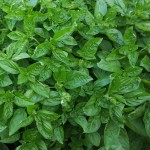 Basil –Ocimum basilicum, a member of the mint family, basil is an annual that comes in seemingly infinite varieties. For your bouquet garni, you want to grow any variety that is a sweet basil. A flavorful favorite is the heirloom variety, Genovese.
Basil –Ocimum basilicum, a member of the mint family, basil is an annual that comes in seemingly infinite varieties. For your bouquet garni, you want to grow any variety that is a sweet basil. A flavorful favorite is the heirloom variety, Genovese.
Basil is easily grown from seed. If you have a long, hot summer you can sow the seeds directly in your sunny garden. For those of us who live further north, it’s best to start basil indoors 8 weeks before your last frost date. Don’t move your plants outdoors until all danger of frost is past. Basil is originally from tropical areas of India, so it can’t withstand cold weather. The hotter the temperature, the better your basil will grow. Just don’t let it flower. Flowering causes the leaves to taste bitter. Aggressively pinch off all flowers to keep your basil producing all summer. Basil grows great in containers. Just make sure that they are well-watered. Don’t let your plants dry out.
You can begin harvesting leaves when your basil reaches a height of six inches. Don’t remove all or most of the leaves at once or you may kill your plant.
Bay Laurel – Laurus nobilis, is actually a tree that is native to the Mediterranean and hardy here in the US from zones 8-10. North of zone 8, it is usually grown in containers that are brought indoors during the winter. Grown outdoors, it can reach a height of 30 to 60 feet. In containers, it is usually kept pruned to a maximum of 6 feet.
Bay laurel grows well in full sun to part shade. It is drought tolerant so don’t over water it. It likes a good watering and then dry out completely before you water it again. Bay laurel is difficult to grow from seeds so it is usually propagated by cuttings.
The leaves are commonly used dried. You can begin harvesting leaves when your tree reaches a height of 2 feet. Choose the largest leaves to dry because they contain the most essential oil, eucalyptol, which is the flavoring you seek for your soups and stews.
Lay the leaves on a paper towel in a cool, dark spot for about a week. Then store them in an airtight glass jar. They can be stored for up to a year. Freshly dried bay leaves have a superior flavor to the dried leaves you buy at the store.
Salad Burnet – Sanguisorba minor, is a short-lived perennial native to the Western Mediterranean area. It was brought to North America by the early colonists. It is hardy in zones 4 through 8. Salad burnet grows only to 12 to 18 inches making it ideal for growing in containers.
It will grow in full sun or light shade. Once established, it is drought tolerant. It will readily reseed itself in your garden. Salad burnet is used fresh, lending a light cucumber flavor to your dishes. Use young leaves for the best flavor. The older leaves are bitter.
Chervil – Anthriscus cerefolium, also known as French Parsley, it looks like parsley but tastes like fennel or tarragon. It is hardy as far north as zone 6 and grows to 2 feet. Like parsley and cilantro, it is a cool season plant and will bolt, or go to seed, in the hot temperatures of summer.
It is easily grown from seed and should be direct sown in your garden. It develops a long tap root so it doesn’t transplant well. Keep it moist and lightly shaded.
Chervil is always used fresh. When harvesting your chervil, be sure to leave at least ⅓ of the leaves on the plant. Regular harvesting of chervil helps delay bolting.
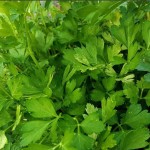
Flat Leaf Parsley
Parsley – Petroselinum crispum, a member of the carrot family, parsley comes in three varieties: flat leaf, curly leaf and root parsley. For your bouquet garni, you want to grow the flat leaf. Parsley is a biennial in its native Mediterranean habitat. North of zone 6, it is grown as an annual because it doesn’t survive the harsh winters. The milder winters of the south are actually good for parsley. It is a cool weather plant that struggles in the summer heat.
Parsley is easy to grow from seed but you have to be patient. It takes 4 to 6 weeks to germinate. You can shorten that time by soaking the seeds in water for 24 hours before planting them. Parsley can be started indoors as long as you can provide lots of light or direct sown in your sunny garden after your last frost date. Mature plants reach 2 to 3 feet in height. Keep them well watered during the growing season, especially if you are growing parsley in containers. Don’t let the plants dry out.
To harvest your parsley, cut the stems close to the ground, starting with the oldest, outside ones. Pruning your parsley like this encourages new growth. Wash it well. Swallowtail butterflies lay their eggs on parsley. The eggs hatch into caterpillars which also “prune” the parsley. Their droppings provide welcome fertilizer.
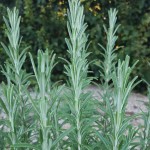 Rosemary – Rosmarinus officinalis, native to the Mediterranean area, rosemary is a woody perennial that is reliably hardy through zone 7. It can survive mild winters with protection in zone 6. In northern areas, rosemary should be grown in containers and brought inside once the outdoor temperatures are less than 30°F. Mature plants grown outside can reach a height of 5 feet. Rosemary is a member of the mint family but is not invasive. It is often used as an ornamental shrub because it can be pruned into hedges and topiary.
Rosemary – Rosmarinus officinalis, native to the Mediterranean area, rosemary is a woody perennial that is reliably hardy through zone 7. It can survive mild winters with protection in zone 6. In northern areas, rosemary should be grown in containers and brought inside once the outdoor temperatures are less than 30°F. Mature plants grown outside can reach a height of 5 feet. Rosemary is a member of the mint family but is not invasive. It is often used as an ornamental shrub because it can be pruned into hedges and topiary.
Rosemary is usually propagated by cuttings. Start your cuttings 6 weeks before your last frost date. After the last frost date, rosemary should be planted in a sunny garden and not overwatered. It can be treated similar to your lavender. Because rosemary requires a lot of sun, when brought indoors, supplemental lighting is recommended. Leaves can be harvested year round.
Savory – a member of the mint family, savory comes in two varieties: summer savory (Satureja hortensisa), which is an annual, and winter savory, which is a perennial. Despite being members of the mint family, neither one is invasive. For your bouquet garni, you want to grow summer savory.
Summer savory is easily grown from seed. You can either direct sow the seeds in your sunny garden after the last frost or you can start them indoors 4 to 6 weeks before the last frost. Be patient! Summer savory seeds are slow to germinate. Mature plants will reach 18 inches in height. Once established, summer savory prefers to be dry. This makes it perfect for container growing since containers dry out quickly if you don’t water every day.
Summer savory can be harvested within six weeks. The plants should be a minimum of six inches high before the first harvest. Wait at least another month before you begin regular harvesting of the leaves and stems. Regular harvests keep the plants pruned. They tend to be top heavy and should be kept to a height of 12 inches.
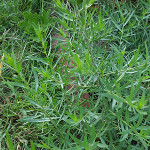 Tarragon – a member of the aster family, there are usually two varieties available: French Tarragon and Russian Tarragon which is much less flavorful. Not surprisingly, for your bouquet garni you want to grow the French Tarragon (Artemisia dracunculus). Tarragon is perennial in zones 4 through 8. During the winter, it becomes dormant.
Tarragon – a member of the aster family, there are usually two varieties available: French Tarragon and Russian Tarragon which is much less flavorful. Not surprisingly, for your bouquet garni you want to grow the French Tarragon (Artemisia dracunculus). Tarragon is perennial in zones 4 through 8. During the winter, it becomes dormant.
French Tarragon cannot be grown from seed so you will need to buy a plant or if you are fortunate to know a fellow gardener who is dividing their tarragon, you can ask for a division. Tarragon grows from rhizomes which should be divided every three to four years to prevent crowding and maintain maximum production. Tarragon roots are very shallow so be careful when weeding around it.
Tarragon loves a hot, dry spot. Plant it in full sun and allow it to dry out between waterings. If you are growing it in a container, do not mix it with other herbs that need to be watered frequently. Mature plants will reach a height of three feet.
To harvest your tarragon, cut the top ⅓ of each branch. Prune it regularly to keep the entire plant at a height of 18 inches to 2 feet or it may be prone to falling over. That will also prevent flowering which reduces the intensity of the flavor in the leaves.
Thyme – (Thymus vulgaris) a member of the mint family, thyme is native to the Mediterranean area. It is a small, shrubby perennial that is hardy through zone 5. Mature plants range in size from 6 to 12 inches, depending on the variety.
Thyme is difficult to grow from seed. It is usually propagated by division or cuttings. Thyme prefers a sunny location, but it can tolerate a little shade. What it can’t tolerate is over watering. Thymes are drought tolerant plants like lavender and rosemary and should be treated the same. You can harvest your thyme any time after it becomes established in your garden.
Make your bouquet garni: the recipe will tell how much of each herb you need. If you are using fresh herbs, tie them together with some string then add to your sauce. If you are using dried herbs, make a pouch out of cheesecloth, place the herbs inside, tie it shut and add to your sauce. Remove your bouquet garni when your dish has finished cooking.
More Herb Blends
Chinese Five Spice Blend
Curry Blend
Fines Herbes
Herbes de Provence
Italian Seasoning
Old Bay Seasoning
Paprika
Poultry Seasoning
Za’atar

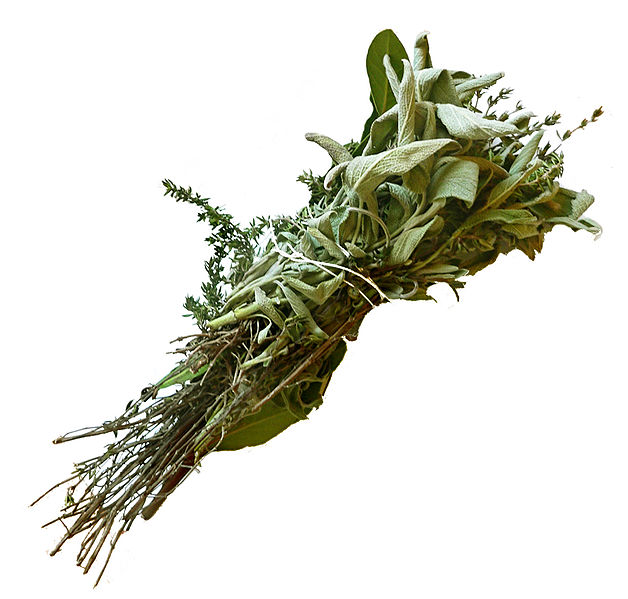
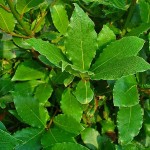
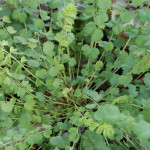
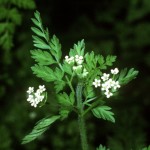
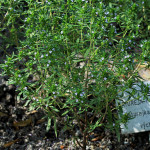
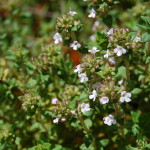
3 Comments on “Grow Your Own Bouquet Garni”
Pingback: Bundles of Flavor From Your Herb Garden | Advice From The Herb LadyAdvice From The Herb Lady
The rewards of growing herbs are far greater than with other plants. Other plants in the garden are mostly planted for their decorative value. Herbs, on the other hand, can also be used for a myriad of other purposes that stretch from flavouring your food to curing your flu to ridding your home of insects.
Pingback: SG555: How to Grow a Gorgeous Garden Using Less Water with Pam Penick - 6ftmama